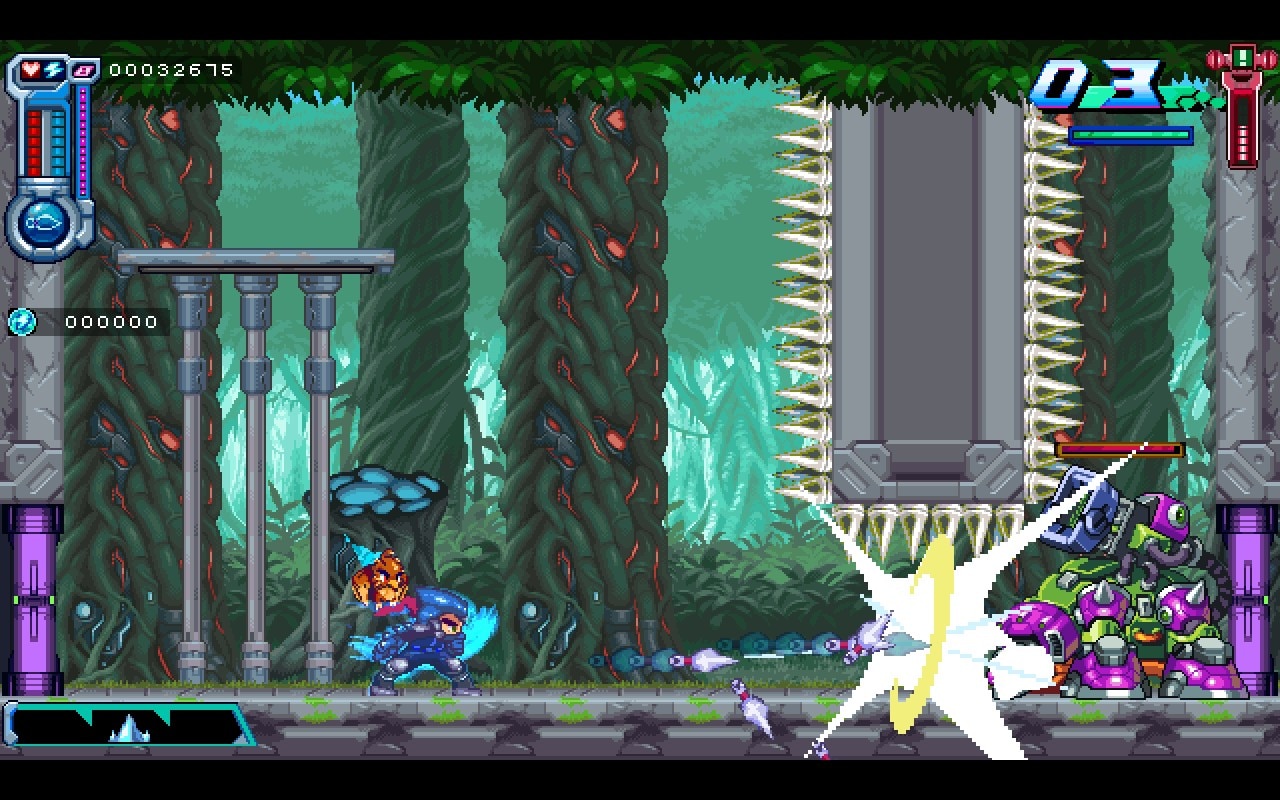Inspiration can strike at any time and the result can take many forms. Berserk Boy demonstrates those principles literally. This is a 2D platformer that wears its inspirations on its sleeve: Mega Man, Azure Striker Gunvolt, and a touch of Sonic the Hedgehog for good measure. That’s alright – everything comes from something. What matters most is the form that inspiration takes. It needs to be more than just the sum of its parts and go beyond the things that inspired it to stand on its own. Berserk Boy not only stands on its own, it breaks into a sprint, building speed until it becomes an impressive flash of inspiration.
In Berserk Boy, you dash into enemies in order to “tag” them, which you can then follow up on by pressing a button to zap them with electricity. At least sometimes, anyway. At other times, you twirl around punching enemies with fiery fists in between bouts of drilling into the ground. That’s when you’re not speeding through stages as a ninja, tossing shurikens and using the environment to your advantage. You can do a lot of different things in Berserk Boy, it all depends on the form you decide to take at any given moment.
Form-swapping serves as the foundation of Berserk Boy’s gameplay. Over the course of the game, you unlock five different Berserk forms. Each one feels like you’re controlling a character from a different game, which the level design reflects. Many obstacles are built with a specific form in mind, like the aforementioned ground you need to drill through or power generators that need to be zapped with lightning in order to unlock gates. Other scenarios prove more ambiguous, like rooms that spawn enemies. Technically the solution for these challenges comes down to personal preference, but some forms are more efficient than others depending on the enemy. In essence, Berserk Boy revolves around recognizing which form fits the situation and then efficiently utilizing its abilities.
This setup consistently keeps you on your toes, establishing a unique identity for the game. Speeding through a level requires cycling through all of these different gameplay styles in an efficient manner. Despite the differences between the forms, the game has a flow to it that prevents the frequent swapping from feeling cumbersome. When it all comes together, it’s a lot of fun. The variety of the gameplay, the flashiness of the visuals, and the energy of the soundtrack combine to create a frenzy of action befitting of a game where everyone shouts about how they’re going “BERSERK!” all the time.
All of the forms control well, but they come with a learning curve. Taken in a vacuum, all of the mechanics make sense. However, for someone like me it can take a surprising amount of effort to fight against years of ingrained platformer instinct to follow Berserk Boy’s rules. When I see a handle bar, I’m going to jump over and try to latch onto it. If you do that in any form except the ninja, however, you’ll send yourself careening down a bottomless pit. Only ninjas know the ancient art of closing their hands to grip things, sorry! The game makes efforts to signpost when you should change forms, it just doesn’t do so consistently and little things like the handle bar problem slipped through my brain’s cracks even after I should know better. Perhaps some slightly more overt visual design could solve this admittedly minor issue.
Mixups happen partly by design, as the game intentionally ramps up in complexity. Like Mega Man, you gain new forms by defeating bosses. Unlike Mega Man, you obtain them in a set, linear order. This decision allows for level design that gradually grows more complex and varied the further you get. Going from one Berserk form to five makes a huge difference in the amount of curveballs each level throws at you. While I enjoy the open-ended nature of Mega Man’s design principles, I’ve always felt like a game that forces you to take advantage of your arsenal throughout the entire game rather than just the handful of end levels would be interesting. Berserk Boy delivers on the concept in a satisfying way.
I am slightly less satisfied by the exploration elements of the level design. Emblems and people in need hide throughout each stage. Collecting them offers rewards like special EX stages to challenge. In principle, that works fine enough as an incentive to replay stages to thoroughly unearth its secrets.
First of all, the level design doesn’t always accommodate the scope of the exploration as well as it should. Most collectibles lie off the beaten path, yet it can be surprisingly difficult to tell which path happens to be the beaten one. Sometimes you’ll spot a secret tube that sends you up to a bonus area, yet more often than not you’ll find yourself at a crossroads room with paths to the left and right sides of the screen. One leads down a completely optional path full of collectibles, the other simply brings you closer to the end of the level. If there’s a way to tell which is which, I never discovered it! If you go down the “wrong” path, you’ll simply need to go back through the level and try again. Teleporters set across the stage theoretically alleviate the need for a restart, but when combined with another element of the exploration experience, it rarely feels worth the effort.
To cut to the heart of the problem, the exploration comes across as a little too transparent in its intentions. The collectibles exist to get you to replay the stages, and you’re gonna replay them whether you like it or not. Even if you sniff out all of the hidden routes available the first time around, you’ll discover that you can’t actually take advantage of them all. At least one or two routes will require Berserk forms that you won’t have by that point in the game yet. Additionally, specific doors force you to uncover 60% of the stranded citizens in the stage before they open. These are virtually always placed well before you can actually find that many in the stage, and in fact you will likely need the aforementioned missing forms to reach that threshold.
While I don’t mind exploration or even coming back to stages to explore them later, I do mind such brazen busywork. The current setup can require you to scour through a stage at least three times: the first time through, the second time with your full arsenal, and then a third time to double back to the 60% door and then finish out the stage. That’s assuming that you find every secret between those runs. It can be surprisingly easy to miss things, and without an easy way to keep track of where you’ve been, backtracking through a stage just to spot a single ladder or pipe you didn’t notice the last few times feels like a chore.
If all of this were optional then none of this would be a big deal, but as it turns out you need to collect a certain amount of items before unlocking the real ending to the game. I’ll admit, the requirement is easily attainable after replaying just a handful of levels. You don’t need to get absolutely everything in the game or even everything in a single stage.
However, the time I spent backtracking exposed to me how flawed this particular aspect of Berserk Boy happened to be. Without this necessary detour, I would not have felt the need to write so many paragraphs about this otherwise small part of the experience. While getting the true ending didn’t tax me too badly, it became clear during that process that this would unfortunately not be a game I’d want to 100% complete in its current state.
On top of finding collectibles, you can also chase high scores for ranks. The ranking system fits the strengths of Berserk Boy nicely, yet even that gets tainted by some slight tedium. If you die, you might as well just restart the level entirely as the score deduction will knock you down a peg. That would be fine, except you can’t just restart a stage from the beginning. You need to pause the game, open some menus, go back to the home base, talk to the commander guy, open up the level menu, and then pick your stage again. I may be getting a little petty here – the collectible stuff kinda set me off. I just don’t think a “restart” button is too much to ask for in a game like this these days!
Don’t get me wrong: Berserk Boy’s main game ends up being a great time, I’d just prefer it stuck to its strengths. Even then, most of its faults boil down to the little things. These flaws aren’t fatal and I do think they’re largely salvageable. A map screen for individual levels like the one you can view at the home base would help the exploration element immensely, and a restart button would make score chasing far more tolerable.





















